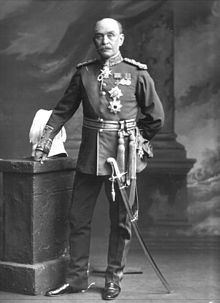Years of service 1866–1914 | Allegiance United Kingdom | |
 | ||
Service/branch British ArmyBritish Indian Army Units 95th (Derbyshire) Regiment of Foot, 129th Duke of Connaught's Own Baluchis Books Victoria Cross 1856‑1920, Distinguished Service Order 1st, Distinguished Service Order 6th Similar Queen Victoria, Francis Aylmer Maxwell, Thomas Cadell | ||
General Sir Garrett O'Moore Creagh VC, GCB, GCSI (Irish: Gearóid Ó Mórdha Mac Giolla Craobhach; 2 April 1848 – 9 August 1923), known as Sir O'Moore Creagh, was a senior British Army officer and an Irish recipient of the Victoria Cross, the highest award for gallantry in the face of the enemy that can be awarded to British and Commonwealth forces.
Contents
Background
Creagh was born in Cahirbane, County Clare, on 2 April 1848, the seventh[1] son of Captain James Creagh, RN, and his wife, Grace O'Moore.
Creagh was married twice, firstly to Mary Longfield (or possibly Brereton) in 1874, who died in 1876, and then to Elizabeth Reade in 1891. He had three children, one of whom was Major General Sir Michael Creagh.
In 1866, after training at the Royal Military College, Sandhurst, Creagh was commissioned into the 95th (Derbyshire) Regiment of Foot and in 1869 was posted to India, being transferred to the British Indian Army the next year.
Second Anglo-Afghan War
Creagh was 31 years old, and a captain in the Bombay Staff Corps during the Second Anglo-Afghan War, when the following deed on 22 April 1879 at Kam Dakka, on the Kabul River, Afghanistan, took place for which he was awarded the VC:
On the 21st April Captain Creagh was detached from Dakka with two Companies of his Battalion to protect the village of Kam Dakka on the Cabul River, against a threatened incursion of the Mohmunds, and reached that place the same night. On the following morning the detachment, 150 men, was attacked by the Mohmunds in overwhelming numbers, about 1,500 ; and the inhabitants of Kam Dakka having themselves taken part with the enemy, Captain Creagh found himself under the necessity of retiring from the village. He took up a position in a cemetery not far off, which he made as defensible as circumstances would admit of, and this position he held against all the efforts of the enemy, repeatedly repulsing them with the bayonet until three o'clock in the afternoon, when he was relieved by a detachment sent for the purpose from Dakka. The enemy were then finally repulsed, and being charged by a troop of the 10th Bengal Lancers, under the command of Captain D. M. Strong, were routed and broken, and great numbers of them driven into the river. The Commander-in-Chief in India has expressed his opinion that but for the coolness, determination, and gallantry of the highest order, and the admirable conduct which Captain Creagh displayed on this occasion the detachment under his command would, in all probability, have been cut off and destroyed.
Later career
In 1878 he became captain of the Merwara battalion, commanding them from 1882 until 1886. He assumed command of the 29th (Duke of Connaught's Own) Bombay Infantry (2nd Baluch Battalion) in 1890, and was promoted to Assistant Quarter-master General in 1896. He commanded the Indian contingent during the Boxer Rebellion in China in 1900, and was in September 1901 appointed General Officer Commanding the Force after the departure of General Gaselee. He was knighted as a Knight Commander of the Order of the Bath (KCB) in 1904 and promoted to general in 1907, becoming the Military Secretary to the India Office the same year.
Creagh succeeded Lord Kitchener as Commander-in-Chief, India, in 1909, retiring in 1914. During the First World War he served as the military advisor to the Central Association of Volunteer Training Corps. He died at 65 Albert Hall Mansions, London SW9, on 9 August 1923.
His Victoria Cross is displayed at the National Army Museum in Chelsea, London, England.
